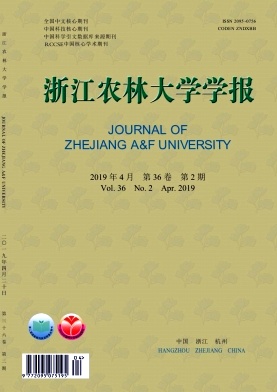-
麝类Moschus spp.动物是重要的资源动物[1-2],所分泌的麝香被广泛用于传统医药及香水业。因其过度利用、生境丧失等原因,麝已极度濒危[3],所以麝类圈养是天然麝香可持续利用的生产方式,也是重要的麝类迁地保育手段。对麝类行为的观察和研究是对麝类进行圈养和迁地保育的前提和基础[4]。因野生麝具有独居性、领域性和警觉性等极强的特点,对麝的行为和行为生态研究主要在圈养系统进行[5]。迄今,诸多学者对麝类动物的领域行为[6]、哺乳[7]、繁殖行为[8]及行为谱[9]等开展了研究,上述研究多基于单类行为量化进行,难于全面挖掘行为的综合信息。基于对行为流的取样和全行为信息的综合挖掘,孟秀祥等[10]采用行为多样性分析方法,对圈养马麝Moschus sifanicus的行为多样性指数进行计算,较好地确定了行为表达与圈舍和年龄、性别等生理特征的关系。麝类动物的麝香分泌集中发生于5-7月[11],其分泌量受年龄和个体来源[12]、饲料营养[13-14]、疾病[15]、激素[16]、饲养方法[12]等影响。对麝香分泌的行为研究较少,零星研究多基于对小样本林麝Moschus berezovskii和马麝的泌香观察和定性描述(有时仅1~2头动物)[17]。麝类圈养业一直缺乏圈养麝麝香分泌的预测方法,尤其缺乏直观的、操作性较强的行为预测方法。本研究基于行为多样性分析方法,对四川川西高原的圈养林麝泌香期的行为量化取样,确定林麝泌香期的行为表达特征,分析行为多样性指数与麝香分泌的关系,旨在为林麝的迁地保育及麝香生产提供参考。
HTML
-
本研究实施于四川马尔康林麝繁育中心(以下简称麝场)。麝场所在地地势由东北向西南逐渐降低,平均海拔为2 600 m,属低纬度、高海拔的高山峡谷立体气候。冬干夏湿,雨热同季,日照充足,昼夜温差大,年平均气温为5.0~14.0 ℃,年降水量为753.0 mm,年均日照时数为2 000.0 h以上,无霜期为120.0 d。马尔康位于四川省东北部(31°54′N,102°14′E),生物资源丰富,是国家重要木材生产基地。野生植物主要有冷杉Abies fabri,云杉Picea asperata,落叶松Larix gmelinii,高山栎Quercus aquifolioides,槭树Acer saccharum以及水桦Betula nigra等;大型草食性动物主要有牛羚Budorcas taxicolor,藏原羚Procapra picticaudata,白唇鹿Gervus albirostris,梅花鹿Cervus nippon等。
-
林麝被饲养于150 m2的圈舍,饲养林麝5~7头·圈舍-1。圈舍活动场基地为混凝土,中央有2~4 m2的凉棚。林麝饲料由精饲料和干、湿树叶组成,精饲料主要成分为玉米Zea mays粉和莴笋Lactuca sativa var. angustanaIrish,莲花白Brassica oleracea var. capitata等时鲜蔬菜,树叶采摘于当地的野生林麝生境。夏季饲喂时间为6:00-8:00和16:00-18:00,冬季饲喂时间为7:00-9:00和15:00-17:00。每个圈区有专职饲养员负责林麝的饲养管理。饲养员饲喂时观察林麝摄食量和健康程度,隔1周进行圈内清扫工作,其余时间林麝不受外界干扰。
本研究涉及57头圈养雄性林麝。按年龄区分年龄组:亚成体(≤ 2岁,27头),成体(3~8岁,23头)和老年组(≥ 9岁,7头)。
-
数据采集于2016年5月1日至7月31日。为保证行为样本的代表性,行为取样于圈养麝的晨昏活动高峰期(6:00-8:00;17:00-20:00)[18],用10×50°望远镜协助行为取样,行为类别及定义参照圈养马麝的行为谱[9]。记录行为的发生频次、持续时间、发生位点等行为变量。各个行为信息持续监测时间为10 min。记录林麝的每次摄食量。
依据林麝的每日摄食量及生理反应等指标[11, 16],将雄麝麝香分泌分为5个时期(表 1)。
麝香分泌时期 麝的生理反应特征 前期 雄麝正常摄食精饲料和干湿树叶,无剩余 初期 雄麝的摄食量开始减少,定量添加的饲料出现剩余,睾丸、阴囊出现肿胀下垂,香腺体积增大 盛期 雄麝停食,睾丸、阴囊持续肿胀增大,香囊明显可见,活动减少,仅展现卧息和安静站立 末期 雄麝开始恢复摄食,定量添加的饲料有剩余,睾丸、阴囊及香腺开始缩小,肿胀消退 后期 雄麝摄食恢复正常,饲料无剩余 Table 1. Periods of musk secretion
将泌香初期、盛期和末期定义为泌香中期。计算样本行为流的绝对行为多样性指数H(absolute diversity index)[10, 19]。计算公式:$H = \sum\limits_{i = 1}^n {} \left( {{P_i}{\rm{ }}{{\log }_2}{\rm{ }}1/{P_i}} \right), {P_i} = {f_i}{\rm{ /}}\sum\limits_{i = 1}^n {} {f_i} $。其中:fi为样本行为流里第i种行为的发生频次,f为每次取样观察记录的总频次。Hall=log2 N。其中:N为圈养林麝的行为谱所含行为型个数,Hall代表圈养林麝的最大行为多样性指数,即行为谱的N种行为均概率出现。R=H/Hall,即相对行为多样性指数,反映了特定环境下或特定类群的具体行为多样性指数H和Hall的相对关系。
将个体的行为多样性指数区分为低行为多样性组(R<0.3),中行为多样性组(0.3≤R≤0.4)和高行为多样性组(R>0.4)。
-
采用Kolmogorov-Smirnov Test检验行为多样性指数的正态性,如数据呈正态分布,则用方差分析(ANOVA)检验各目标变量间的差异显著性。如数据及变换后数据呈明显非正态分布,选用Mann-Whitney U Test和Kruskal-Wallis Test分析变量间的差异显著性。变量间的相关性采用相关系数法。设定差异显著性标准为P=0.05,差异极显著性标准为P=0.01。所有数据分析通过SPSS 21.0软件进行。
1.1. 研究地点
1.2. 研究对象
1.3. 数据采集与整理
1.4. 数理统计
-
泌香前期行为多样性(0.336 ± 0.015,n=59)年龄组间差异不显著(F=2.782,P>0.05),老年组林麝的行为多样性指数(0.274 ± 0.029,n=14)显著低于亚成体组(0.357 ± 0.019,n=38,P<0.05),成体的行为多样性指数居中(0.349 ± 0.037,n=7)。
林麝泌香中期行为多样性(0.346 ± 0.013,n=71)与年龄组间差异不显著(F=1.911,P>0.05),随年龄上升,其行为多样性指数有上升趋势。
泌香后期行为多样性(0.370 ± 0.007,n=206)年龄组间差异显著(F=4.524,P<0.05),老年个体的行为多样性指数(0.336 ± 0.015,n=49)显著低于亚成体(0.372 ± 0.011,n=84,P<0.05),并极显著地低于成体(0.390 ± 0.010,n=73,P<0.01)(图 1)。
-
林麝麝香分泌期的行为多样性指数与其泌香量相关不显著(r=-0.016,n=57,P>0.05)。行为多样性指数中等林麝的泌香量[(12.300 ± 0.670)g,n=33]高于行为多样性指数最高林麝[(11.360 ± 1.330)g,n=14]及行为多样性指数最低林麝[(11.500 ± 1.710)g,n=10],但行为多样性指数对泌香量的效应不显著(F=0.476,P>0.05)。
泌香前期行为多样性指数与泌香量相关不显著(r=0.467,n=5,P>0.05),行为多样性低的个体其泌香量相对较低,低于行为多样性中等个体平均泌香量(14.110 ± 2.140,n=4),但差异不显著(P>0.05)。
泌香中期行为多样性指数与泌香量相关不显著(r=-0.051,n=15,P>0.05),行为多样性对泌香量的效应不显著(F=0.668,P>0.05),行为多样性指数低的个体泌香量最高[(14.670 ± 1.760)g,n=3],行为多样性中等的个体泌香量最低[(11.430 ± 1.670)g,n=7]。
泌香后期行为多样性指数与泌香量相关不显著(r= -0.014,n=47,P>0.05),行为多样性高低对泌香量的效应不显著(F=1.393,P>0.05)。多样性指数中等的林麝泌香量最高[(12.320 ± 0.756)g,n=28],指数较低的个体泌香量最低[(10.140 ± 2.190)g,n=7](表 2)。
麝香分泌时期 行为多样性指数分组 泌香量/g 个体数/个 低 11.500 ± 1.710 10 分泌期 中 12.300 ± 0.670 33 高 11.360 ± 1.330 14 泌香前期 低 9.720 1 中 14.110 ± 2.140 4 低 14.670 ± 1.760 3 泌香中期 中 11.430 ± 1.670 7 高 13.400 ± 2.140 5 低 10.140 ± 2.190 7 泌香后期 中 12.320 ± 0.756 28 高 10.150 ± 1.280 13 Table 2. Behavioral diversity index grouping and musk production
2.1. 麝香分泌期行为多样性指数与年龄组的关系
2.2. 麝香分泌期行为多样性与泌香量的关系
-
中国的麝类圈养经过近60 a的发展,促进了麝香可持续生产,已成为濒危麝类动物迁地保育的优秀范例。马尔康麝场隶属于四川养麝研究所,始建于1958年,是中国人工养麝的创始单位,在麝的迁地保育、饲养管理和活体取香等方面已取得比较成熟的经验。
行为多样性基于分析动物总行为元素和行为频次,直观反映动物行为流的特征[20]。动物行为流里发生的行为元素越多,行为发生的可预见性越小,总体的信息含量越大,即行为多样性值越大[10]。本研究中的雄林麝在麝香分泌期的行为多样性指数(0.359 ± 0.006)明显低于甘肃兴隆山马麝行为多样性指数(0.450 ± 0.010)[10]。在麝香分泌期,麝类动物的活动性较低,表达的行为类型和频次均极为有限,在泌香盛期时甚至仅展现静卧行为,这直接导致了本研究中林麝的行为多样性指数较低。再则,由于林麝和马麝的行为格局存在种间差异,如张保良[11]报道:相对林麝,马麝的活动性更大;李红亮等[12]也报道:马麝对圈养和人工圈养环境的反应更加强烈,相比圈养林麝,展现更多的高强度应激行为,行为表达和替换更频繁。此外,孟秀祥等[10]对马麝的行为多样性指数计算是基于5 min的行为样本进行,而本研究的行为取样是10 min,单元取样时间的不同是否对行为多样性指数的计算产生效应,有待进一步验证。
麝类动物在泌香中期会展现特定的行为和生理反应,雄麝在此时期减食甚至停食,多静卧[11]。与此一致,本研究的麝场圈养林麝的亚成体在泌香中期的行为多样性指数显著较低。因亚成体雄麝是首次泌香,其泌香反应相对更加剧烈,相比其他年龄个体,其活动性较低,展现更多的静卧[11]。这将直接导致其行为冗余增加、行为多样性相对较低。
圈养动物普遍有刻板行为的发育,导致行为多样性降低。动物被圈养时间越长,受圈养环境胁迫越大,其刻板发育和表达强度越大,对行为多样性的降低效应就越显著[21]。在本研究中,圈养林麝在泌香中期外的泌香前期和后期的行为多样性变化趋势相近,老年个体的行为多样性指数均显著低于亚成体和成体,说明被圈养时间越长,其行为多样性越低。这与圈养猪等家畜的研究结果一致[19]。孟秀祥等[5]的研究也表明:圈养马麝的刻板行为表达强度与其受圈养年限呈正相关。此外,随圈养林麝的年龄增大,体质、疾病等多种因素也会对其一般行为表达及活动性产生降低效应,导致老龄圈养林麝的行为多样性较低。
本研究表明:麝香分泌期行为多样性适中的雄麝泌香量最高,而行为多样性最低和最高个体的泌香量相对较低。圈养动物行为多样性过低,部分原因在于刻板行为的大量表达[21],如圈养麝的高强度的刻板性往返走及侵犯等[5]。因此,大量的刻板行为表达将耗费大量能量,并将占用时间和营养分配,从而影响对麝香分泌这一高耗能的生理过程,导致其泌香量受影响。此外,行为多样性过高的圈养麝的活动性过大,一方面耗费能量,另一方面,将直接影响麝香初香液的分泌及在香囊中的熟化[22],从而影响其麝香分泌和产量。总而言之,行为多样性适中的圈养林麝的麝香产量最高,这一结果可以应用在麝类圈养中,作为提高麝香产量的手段。








 DownLoad:
DownLoad: